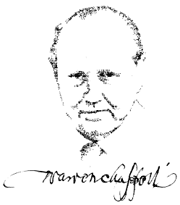Name Warren Chappell | Role Author | |
 | ||
Books A short history of the printed word, The living alphabet Similar People Robert Bringhurst, Jack London, Philip R Goodwin | ||
Warren Chappell (1904, Richmond, Virginia–1991, Charlottesville, Virginia) was an American illustrator, book and type designer, and author.
Contents
Education
He was a graduate of the University of Richmond, and then studied at the Art Students League of New York, under Boardman Robinson, where he later taught. In 1931-2 he studied type design and punch-cutting under Rudolf Koch at the Design School Offenbach in Germany. In 1935 he studied illustration at the Colorado Springs Fine Arts Center. The University of Richmond awarded him an honorary D.F.A. in 1968. In 1970 his work in the graphic arts was recognized by the Rochester Institute of Technology, with the presentation of their Goudy Award.
Career
After running his own studio in New York City for several years, Chappell traveled to Germany just before World War II to work at Stempel on the typeface Trajanus. He returned to the United States at the onset of the war, having seen only initial proofs. He first saw the completed typeface in Swedish design magazines during the war. He later devoted himself to book design and illustration and was closely associated with the firm of Alfred A. Knopf for which he designed many books. He also did illustrations for Random House, Harper & Row, and Doubleday. He was typography consultant to both the Book of the Month Club and American Type Founders. He was Artist-in-Residence at University of Virginia in Charlottesville.
John Updike and Chappell worked together on books for children on music, including "The Magic Flute" (1962), "The Ring" (1964) and "Bottom's Dream" (1969). His design for the E. P. Dutton re-issues of A. A. Milne's Winnie-the-Pooh books are considered to be particularly elegant.
